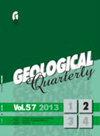伊朗西北部提克梅赫达什以南加雷赫恰伊-库尔莫拉地区含贱金属和贵金属的热液矿脉的成因
IF 0.7
4区 地球科学
Q3 GEOLOGY
引用次数: 0
摘要
Gharehchay-Kurmolla(Gh-Ku)基本金属和贵金属矿区位于大不里士东南 75 公里处的 Tikmehdash 以南约 2 公里处,是西阿尔伯兹-阿扎尔拜詹构造带中 Bostanabad-Miyaneh 含金区的一部分。研究区内的矿化物位于石英脉和细脉中,由始新世火山碎屑岩和花岗岩构成。石英脉和细脉周围可辨认的蚀变带包括硅质、植硅体、中芒硝和丙炔质类型。矿化是在三个明显的阶段形成的。在第一阶段,形成了石英、黄铁矿和黄铜矿等矿物,并含有少量金。在第 2 阶段,形成了石英、方铅矿、闪锌矿、金等矿物以及黄铁矿和黄铜矿。第 3 阶段与石英沉积同时发生,并伴有锰氧化物和氢氧化物(焦绿泥石和黝黄铁矿)。主要的煤矸石矿物为石英、金刚砂、绢云母、绿泥石和方解石。对石英晶体中的原生两相(LV)流体包裹体进行的显微测温研究表明,造成矿化的热液温度和盐度分别为 215 至 325 摄氏度和 2.6 至 10.4 重量%的氯化钠当量。流体的氧同位素组成(+9.7 至 +12.5‰)表明,成矿溶液主要含有岩浆成分。流体的硫同位素组成(-1.5 至 -3.4‰)也表明其来源于岩浆。根据微量测温和稳定同位素分析获得的数据,沸腾和混合是研究区矿石和矸石矿物沉淀的两个重要机制。Gh-Ku 地区的地质和地球化学特征表明,该地区的矿化属于表生型低硫化风格。本文章由计算机程序翻译,如有差异,请以英文原文为准。
The genesis of base and precious metals-bearing epithermal veins in the Gharehchay-Kurmolla area, south of Tikmehdash, NW Iran
The Gharehchay-Kurmolla (Gh-Ku) base and precious metals occurrence is located in ~2 km south of Tikmehdash, 75 km south-east of Tabriz, and is a part of Bostanabad-Miyaneh gold-bearing district in the West Alborz-Azarbaidjan structural zone. Mineralization in the study area occurs in quartz veins and veinlets hosted by the Eocene volcanic-pyroclastic units as well as granite. Recognizable alteration zones around the quartz veins and veinlets include silicic, phyllic, intermediate argillic, and propylitic types. The mineralization was developed during three conspicuous stages. In stage 1, minerals such as quartz, pyrite, and chalcopyrite with slight amounts of gold were formed. During stage 2, minerals such as quartz, galena, sphalerite, and gold together with pyrite and chalcopyrite were developed. Stage 3 was concurrent with deposition of quartz accompanied by Mn-oxides and hydroxides (pyrolusite and psilomelane). The major gangue minerals are quartz, adularia, sericite, epidote, chlorite and calcite. Micro-thermometric investigations on primary 2-phase (LV) fluid inclusions in quartz crystals showed that the hydrothermal fluids responsible for mineralization had temperatures and salinities ranging from 215 to 325°C and from 2.6 to 10.4 wt.% NaCl eq., respectively. The oxygen isotopic composition of the fluid (+9.7 to +12.5‰) suggests that the ore-forming solutions had a largely magmatic component. The sulphur isotopic composition of the fluid (–1.5 to –3.4‰) is also indicative of magmatic origin. On the basis of data obtained from micro-thermometric and stable isotope analyses, boiling along with mixing were two important mechanisms involved in the precipitation of ore and gangue minerals in the study area. The geological and geochemical characteristics of the Gh-Ku area indicate that mineralization in this area is of epithermal type with a low-sulphidation style.
求助全文
通过发布文献求助,成功后即可免费获取论文全文。
去求助
来源期刊

Geological Quarterly
地学-地质学
CiteScore
2.20
自引率
0.00%
发文量
19
审稿时长
>12 weeks
期刊介绍:
The policy of the Geological Quarterly is to publish significant contributions of information and geological insight relevant to an international readership. The journal has been issued since 1957 at the Polish Geological Institute - National Research Institute and, at present, is the leading Earth sciences journal in Poland. All aspects of Earth and related sciences, and universal and broad regional rather than locally oriented topics are covered.
The journal is intended to be an international forum for the exchange of information and ideas, particularly on important geological topics of Central Europe.
 求助内容:
求助内容: 应助结果提醒方式:
应助结果提醒方式:


